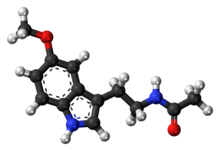Melatonin
Biological Activity and Functions of Melatonin: – Acts as a potent full agonist of melatonin receptors in humans. – Functions as a high-capacity antioxidant within […]
Biological Activity and Functions of Melatonin:
– Acts as a potent full agonist of melatonin receptors in humans.
– Functions as a high-capacity antioxidant within mitochondria.
– Neutralizes free radicals and promotes antioxidant enzyme expression.
– Protects cells against oxidative stress.
– Regulates sleep-wake cycles and drowsiness.
– Melatonin production suppression by sunlight.
– Decrease in melatonin production with age.
Circadian Rhythm and Melatonin:
– Crucial for regulating sleep-wake cycles.
– Peaks between midnight and 8:00 am in infants.
– Diminishes with age and changes during adolescence.
– Recognized antioxidant properties since 1993.
– Twice as effective as vitamin E in combating oxidative stress.
Melatonin and the Immune System:
– Interacts with the immune system with anti-inflammatory effects.
– May impact cytokine production and T cell expansion.
– Potential to mitigate acquired immunodeficiencies.
– Beneficial immunological impact due to high-affinity receptors.
– Interactions with immunocompetent cells recognized but not fully defined.
Weight Regulation and Melatonin:
– Regulates weight gain by inhibiting leptin.
– Modulates leptin’s actions outside waking hours.
– May restore leptin sensitivity during the daytime.
– Effect on leptin resistance contributes to weight regulation.
– Leptin is crucial for energy balance and body weight regulation.
Melatonin Synthesis, Regulation, and Occurrence:
– Tryptophan hydroxylation initiates melatonin biosynthesis.
– Blue light inhibits melatonin biosynthesis.
– Regulated by norepinephrine and cAMP increase.
– Produced in darkness by the pineal gland.
– Occurrence in various organisms, including vertebrates, plants, and invertebrates.
Melatonin, an indoleamine, is a natural compound produced by various organisms, including bacteria and eukaryotes. Its discovery in 1958 by Aaron B. Lerner and colleagues stemmed from the isolation of a substance from the pineal gland of cows that could induce skin lightening in common frogs. This compound was later identified as a hormone secreted in the brain during the night, playing a crucial role in regulating the sleep-wake cycle, also known as the circadian rhythm, in vertebrates.

| |

| |
| Names | |
|---|---|
| IUPAC name
N-[2-(5-methoxy-1H-indol-3-yl)ethyl]acetamide
| |
| Other names
5-Methoxy-N-acetyltryptamine; N-Acetyl-5-methoxytryptamine; NSC-113928
| |
| Identifiers | |
3D model (JSmol)
|
|
| ChEBI | |
| ChEMBL | |
| ChemSpider | |
| DrugBank | |
| ECHA InfoCard | 100.000.725 |
| EC Number |
|
| KEGG | |
| MeSH | Melatonin |
PubChem CID
|
|
| UNII | |
CompTox Dashboard (EPA)
|
|
| |
| |
| Properties | |
| C13H16N2O2 | |
| Molar mass | 232.281 g/mol |
| Melting point | 117 |
Except where otherwise noted, data are given for materials in their standard state (at 25 °C [77 °F], 100 kPa).
| |
In vertebrates, melatonin's functions extend to synchronizing sleep-wake cycles, encompassing sleep-wake timing and blood pressure regulation, as well as controlling seasonal rhythmicity (circannual cycle), which includes reproduction, fattening, molting, and hibernation. Its effects are mediated through the activation of melatonin receptors and its role as an antioxidant. In plants and bacteria, melatonin primarily serves as a defense mechanism against oxidative stress, indicating its evolutionary significance. The mitochondria, key organelles within cells, are the main producers of antioxidant melatonin, underscoring the molecule's "ancient origins" and its fundamental role in protecting the earliest cells from reactive oxygen species.
In addition to its endogenous functions as a hormone and antioxidant, melatonin is also administered exogenously as a dietary supplement and medication. It is utilized in the treatment of sleep disorders, including insomnia and various circadian rhythm sleep disorders.